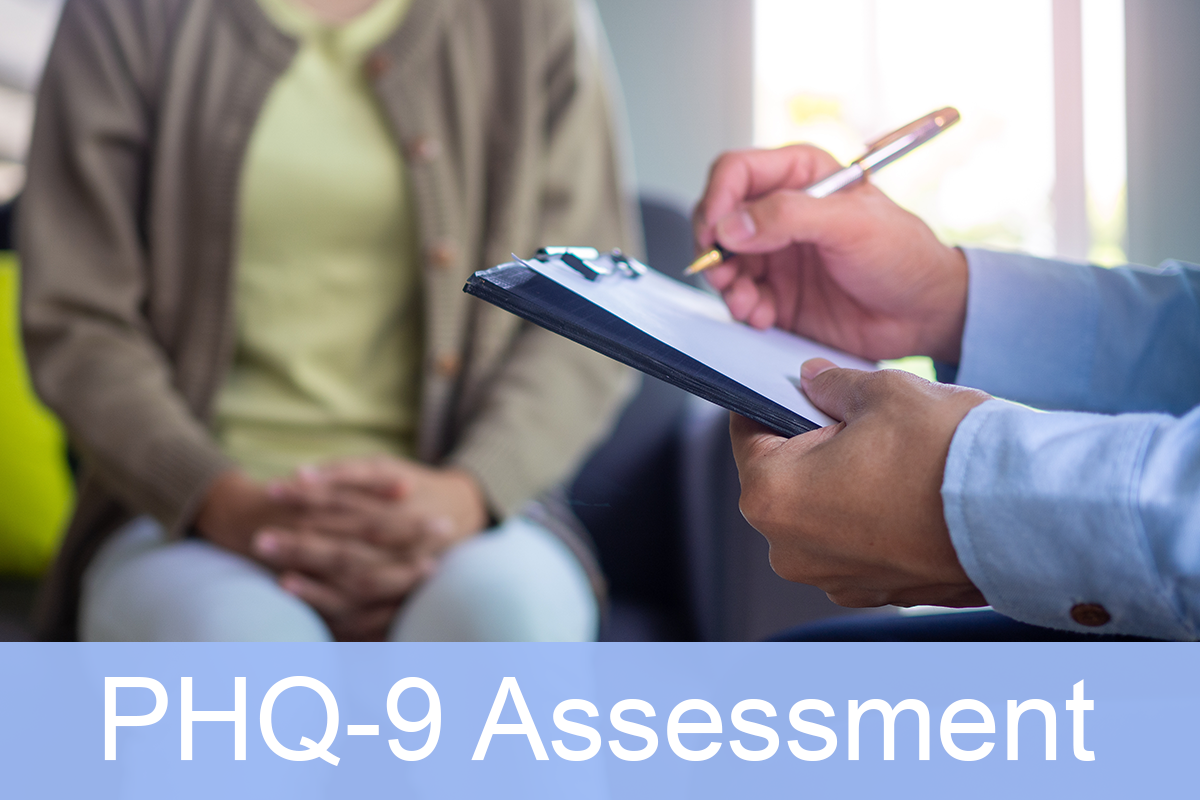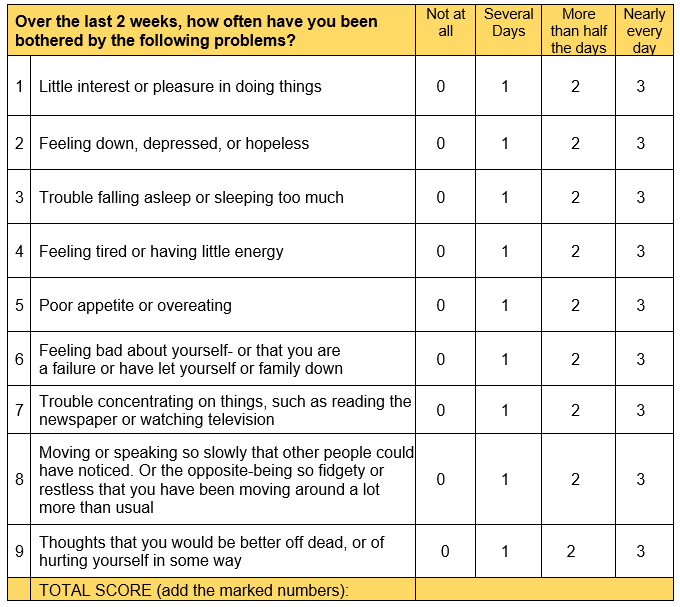Best 2024 Clinical Manual | How Does the PHQ 9 Depression Scale Work?
Top Guide on the PHQ 9 Scoring Tool | What It Is & How It Works. All You Need to Know
If you are a social worker or work in another field of physical or mental health, the PHQ9 form is likely one you’ll run across often, so it’s an important diagnostic tool to fully understand and know how to use.
By reading a PHQ score, a medical or mental health professional can determine whether an individual may be suffering from depressive disorder and the severity of their depression.
In this article, you’ll learn what the PHQ 9 test is, the value of using it, and how to read the PHQ 9 scale. We’ll also go over the suggested next steps based on the PHQ 9 depression severity revealed in the score.

Depression Screen PHQ 9
Depression is an illness that impacts people of all geographic areas and social-economic levels. It’s estimated that approximately 280 million people, or 5% of the world’s population, suffer from a depressive disorder.
One of the most well-known screening tools for depression is the PHQ-9 questionnaire. This quick diagnostic aid is based on the nine criteria for depression that are found in the American Psychiatric Association’s Diagnostic and statistical manual of mental disorders. 4th edition. (DSM-IV)
See Also: Patient Health Questionnaire (PHQ) Scoring & Assessment Guide
Table of Contents: PHQ 9 Questionnaire & Scoring
Keep on scrolling down this page to read each section or click any link below to go directly to that section.
- Where Did the PHQ9 and GAD7 Come From?
- PHQ-9 Test Overview
- Why Is There a PHQ2 and PHQ9?
- PHQ 9 Questions
- PHQ 9 Scoring & PHQ 9 Interpretation
- PHQ 9 Scores Interpretation | Proposed Treatments
- Who Gives the PHQ 9 Assessment?
- Conclusion | PHQ 9 Questionnaire for Depression
- FAQ | PHQ-9 Scores Interpretation
Don’t Miss: What Social Worker Intake Form Types Are Used the Most by Social Workers?
After reading this guide, if you still have questions about GAD 7 PHQ 9 or if there is a depression screening PHQ 9 technique being used by your organization that you would like to provide a review on, then contact the Social Work Portal Team.
Where Did the PHQ9 and GAD7 Come From?
You will often hear PHQ9 GAD7 mentioned together. That’s because the GAD-7 and PHQ-9 were developed by the same group and were funded by an education grant from Pfizer, Inc.
Pfizer, along with research partners Robert Spitzer, M.D. and Janet Williams, D.S.W. from Columbia University, and Kurt Kroenke, M.D. from Indiana University, developed both the PHQ9 and GAD7 questionnaire tools, which were published in 1999.
The GAD screens for anxiety and the PHQ screens for depression. Both PHQ9 and GAD7 scoring is done in a similar way and is based on how often an individual experiences certain symptoms/problems.
In 2010, Pfizer announced that it was making the PHQ9 and GAD7 form questionnaires freely available without copywrite restrictions, and at no cost. Due to that move, it’s now pretty easy to find fillable PHQ 9 and GAD 7 survey PDFs and web based PHQ9 and GAD7 online forms on many sites.
Related: Guide for General Anxiety Disorder (GAD) | Testing, Treatment, and Diagnosis of GAD
Do you have any questions about GAD 7 PHQ 9 forms or where to find a PHQ9 and GAD7 PDF? If so, contact the Social Work Portal Team.
PHQ-9 Test Overview | Key Facts about PHQ 9 Depression Scoring
The depression screening PHQ 9 questionnaire is widely used as a tool to determine depression risk and severity. It is comprised of nine questions that are commonly known indicators of depression.
As noted above, PHQ 9 depression scoring is reflective of the diagnostic criteria for depression in the DSM IV from the American Psychiatric Association.
For each of the nine questions, the respondent will indicate how often within the last two weeks they have experienced the symptom. Whether you take a PHQ 9 online or on a paper form, the multi-choice will be the same.
For each possible choice, a numeric value is given that is between 0-3. All the values are added, and the total is matched to the PHQ 9 scoring scale, which will identify if depression is indicated and the severity of the individual’s depression.
Would you like access to a PHQ-9, GAD-7, and other popular assessment templates? Improve the ease of your client assessments today! Check out our All-in-One Client Assessment & Management Tool.
The PHQ 9 depression test has several benefits that have made it so popular:
- It’s based on the DSM IV diagnostic criteria for depression.
- It’s quick and easy to take.
- Both the GAD 7 and PHQ 9 scoring have been shown to be reliable.
- It doesn’t take a lot of time for a clinician to give the test.
- It lends itself well to being self-administered.
- It can easily be turned into a PHQ 9 online test.
- It provides both an indication of depression and an assessment of the severity.
Popular Article: Facts About Medical Permission Forms
Do you have any questions about the PHQ 9 meaning or where to find a PHQ 9 calculator? If so, contact the Social Work Portal Team.
Why Is There a PHQ2 and PHQ9?
When researching a PHQ score and test, you’ll likely run across another type of PHQ – the PHQ-2. The PHQ 2 and 9 are closely related.
The PHQ 2 is designed as a pre-screener to the PHQ 9 patient health questionnaire 9-question test. It can be used in situations where time is short, such as a busy clinic or emergency room.
The PHQ 2 is a two-question test. The questions actually come from the first two questions on the PHQ 9 screener. The potential score for the PHQ-2 is between 0-6. If someone scores 3 or above, then it’s recommended that the next step be to take the PHQ 9 depression assessment.
Read More: Popular Social Work Case Notes Formats (SOAP, BIRP, GIRP, and DAP Notes Examples)
Top PHQ 9 Questions
There are nine questions used in the PHQ9 tool. The questions are typically symptoms that indicate depression. For each of the nine questions, the individual will choose from four frequency options.
The way that this is phrased in the PHQ 9 assessment tool is, “Over the last 2 weeks, how often have you been bothered by any of the following problems?”
The choices that drive the PHQ 9 rating scale are below, followed by the numeric value given for that answer:
- Not at all (0)
- Several days (1)
- More than half the days (2)
- Nearly every day (3)
Here is the PHQ 9 scoring sheet list of symptom-related questions:
- Little interest or pleasure in doing things
- Feeling down, depressed, or hopeless
- Trouble falling asleep or sleeping too much
- Feeling tired or having little energy
- Poor appetite or overeating
- Feeling bad about yourself – or that you are a failure or have let yourself or family down
- Trouble concentrating on things, such as reading the newspaper or watching television
- Moving or speaking so slowly that other people have noticed. Or the opposite – being so fidgety or restless that you have been moving around a lot more than usual.
- Thoughts that you would be better off dead, or of hurting yourself in some way.

PHQ 9 Assessment Form | PHQ 9 Patient Health Questionnaire 9 Indicators
Related: HIPAA Release Guide | Free HIPAA Compliant Authorization Form
Do you have any questions about the PHQ 9 score meaning, the PHQ9 and GAD7 questionnaire, or the PHQ 9 purpose? If so, click here to contact the Social Work Portal Team.
PHQ 9 Scoring & PHQ 9 Interpretation
The PHQ 9 scale scoring is simple to do by adding the numeric values of the answers to the PHQ 9 questions. With each question having a potential score between 0 and 3, the overall potential PHQ 9 score would be between 0 and 27.
Some people ask, “What is a normal PHQ 9 score?” and “how do you score PHQ 9 results?” Since “normal” is relative, there is not really a normal score. But if you wanted to know the score for no depression indicated, that PHQ 9 scoring would be “0.”
When scoring the PHQ9 form, you total the answers to the nine questions and then use the following PHQ 9 scale to interpret the results:
- 0 – 4: None to Minimal Depression
- 5 – 9: Mild Depression
- 10 – 14: Moderate Depression
- 15 – 19: Moderately Severe Depression
- 20 – 27: Severe Depression
These PHQ 9 results are then documented in a case management tool, and they provide output for creating a recovery plan for that patient.
Don’t Miss: What You Need to Know: SOAP Note Examples, Meaning, Tips & More
Do you have any questions or feedback about this article on the PHQ score, PHQ 9 results, and PHQ 9 GAD Assessments? Are you looking for a PHQ 9 assessment PDF or PHQ 9 test online? Click here to contact the Social Work Portal Team.
Case Management Software – eLearning Resources – Paperless Assessments Sign up today and change the way you work! | |
PHQ 9 Scores Interpretation | Proposed Treatments
The PHQ 9 online assessment manual on Pfizer’s website has some proposed treatment actions / next steps for clinicians to take based on the PHQ 9 forms score.
These PHQ 9 depression treatment actions originate from Kroenke K, Spitzer RL, Psychiatric Annals 2002;32:509-521.
| PHQ-9 Score | Depression Severity | Proposed Treatment Actions |
| 0 – 4 | None-minimal | None |
| 5 – 9 | Mild | Watchful waiting; repeat PHQ-9 at follow-up |
| 10 – 14 | Moderate | Treatment plan, considering counseling, follow-up, and/or pharmacotherapy |
| 15 – 19 | Moderately Severe | Active treatment with pharmacotherapy and/or psychotherapy |
| 20 – 27 | Severe | Immediate initiation of pharmacotherapy and, if severe impairment or poor response to therapy, expedited referral to a mental health specialist for psychotherapy and/or collaborative management |
Popular Article: What Does a Social Worker Really Do? Main Roles of a Social Worker
If you have any reviews or feedback about the PHQ 9 scoring scale and screening tool used by your organization, click here to contact the Social Work Portal Team.
Who Gives the PHQ 9 Assessment?
One of the benefits of the PHQ 9 depression assessment is that it can be given by many different medical or mental health professionals. This includes nurses, intake specialists, social workers, physicians, therapists, and medical assistants.
You can also have a patient take a PHQ 9 self test, either online or while in the waiting room, and then have the scoring and interpretation of the depression screen PHQ 9 done by the clinician.
See Also: Complete Guide to Child Social Services & Social Work With Families
Please let us know if you have any questions about the PHQ9 GAD7, or PHQ2, or are looking for a PHQ9 and GAD7 PDF download or PHQ9 GAD web forms. Click here to contact the Social Work Portal Team.
Conclusion | PHQ 9 Questionnaire for Depression
The PHQ 9 screening is one of the most widely used diagnostic tools to identify symptoms of depression. The test is straightforward and easy to understand, making it useful in just about any medical or mental health setting.
Because the PHQ 9 test can be self-administered, it saves time for medical staff, especially in busy settings, such as emergency rooms. Plus, the combination of the PHQ2 and PHQ9 enables those in busy or time-limited environments to provide a better quality of care and ensure they catch potentially harmful depressive symptoms in a patient.
The PHQ9 and GAD7 scoring are very simple to do, making these universal tests that can be used globally to enhance patient diagnoses and outcomes.
Don’t Miss: What Are the Real Responsibilities of a Social Worker?
FAQ | PHQ-9 Scores Interpretation
What is a PHQ-9 screening?
The PHQ 9 assessment is a short survey designed to identify depression and the severity of that depression.
What is a normal PHQ 9 score?
Since “normal” is relative, there is not really a normal score for the PHQ 9 depression screening. But if you wanted to know the score for no depression indicated, that PHQ 9 scoring would be “0.”
Can the PHQ-9 diagnose depression?
The PHQ-9 test is a diagnostic tool to indicate whether symptoms of depression are present. It is used by medical and mental health professionals to inform their diagnoses.
What are the PHQ9 and GAD7?
You will often hear PHQ9 GAD7 mentioned together. That’s because the GAD-7 and PHQ-9 were developed by the same group and were funded by an education grant from Pfizer, Inc.
The GAD screens for anxiety and the PHQ 9 screening tool screens for depression. Both PHQ9 and GAD7 scoring is done in a similar way and is based on how often an individual experiences certain symptoms/problems.
Note: Content on this website (socialworkportal.com) is copyrighted and protected under applicable copyright laws. Unauthorized reproduction, distribution, or use of any content from the website, without explicit written permission, is strictly prohibited. Read: Terms of Use.
Social Work Portal Disclaimer: Social Work Portal is not a social work agency and we do not refer social workers. This web site is provided for educational and informational purposes only and does not constitute providing medical advice or professional social and healthcare services. The information provided should not be used for diagnosing or treating a health problem or disease, and those seeking personal medical advice should consult with ... Read our full disclaimer here: Social Work Portal Disclaimer.

Image sources: Stock.adobe.com





